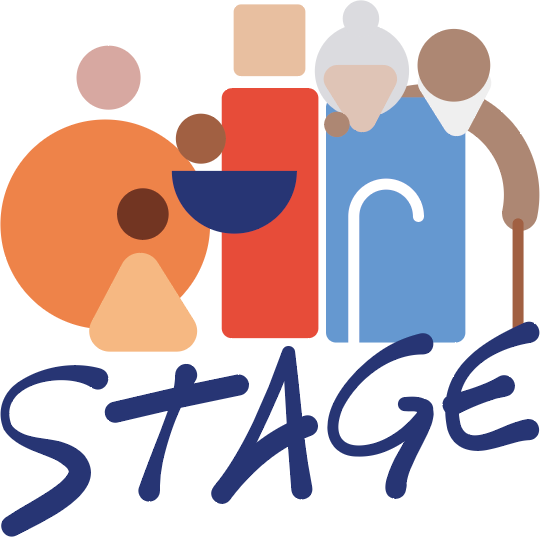
OBESITY AND SARCOPENIA:
WHY MAINTAINING HEALTH ACROSS THE LIFE-COURSE IS VITAL
It’s World Obesity Day, and this year’s theme, “Changing Systems, Healthier Lives,” highlights the urgent need for systemic changes to treat or manage obesity and its complications.
As obesity rates continue to rise globally and populations grow older, one issue gaining increasing attention is sarcopenic obesity – a condition characterised by loss of muscle mass, strength and function, and obesity.
This is not just an individual health concern; a lack of healthcare policies, biased and stigmatising societal attitudes towards ageing and obesity, and health-disrupting environments all play a role. Without early intervention, sarcopenic obesity can lead to an increased risk of falls and fractures, mobility issues, loss of independence, and reduced quality of life. However, prevention across the life-course—through obesity treatment, improved nutrition and physical activity, and policy-driven changes to create health-promoting social and physical environments—can help mitigate its impact.
This blog explores the causes, risks, and preventative strategies for sarcopenic obesity in older adults, raising awareness of why a lifelong approach to health is essential in creating healthier lives for all.

WHAT IS SARCOPENIC OBESITY?
Sarcopenia is the progressive loss of muscle mass and strength, leading to reduced physical function, frailty, and a decreased quality of life. It is associated with a higher risk of falls, fractures, and premature death.
While some muscle loss is a normal part of ageing, sarcopenia accelerates this process, significantly impacting mobility and independence. It is estimated to affect 10-16% of adults worldwide [4], and as the global population ages, this number is expected to rise.

Sarcopenic obesity occurs when age-related reduced muscle mass, strength and function are combined with obesity (excess or dysfunctional body fat). A complex interaction of several factors influences this condition. These include:
• Inflammation resulting from obesity, diabetes, and other chronic conditions;
• Hormonal changes, e.g., decreased testosterone, growth hormone, and oestrogen;
• Health behavioural factors such as low protein intake or high intake of high-calorie,nutrient-poor foods;
• Reduced physical activity or increased sedentary behaviours;
• Metabolic shifts, e.g., metabolic dysfunction, including insulin resistance and chronic inflammation.
Sarcopenic obesity is also linked to an increased risk of chronic diseases such as diabetes, cardiovascular disease, and cancer [5]. Having two or more health conditions (multi-morbidity) likely impacts a person’s optimal ageing by reducing their functional ability and psychological and social wellbeing.

One key challenge is that obesity can mask and accelerate sarcopenia. Traditional anthropometric measurements such as body mass index (BMI) or waist circumference may not detect muscle loss, meaning healthcare professionals must consider other measures such as handgrip strength. This is usually measured using a hand-held dynamometer to determine maximum voluntary muscle strength. It is estimated to affect 10-16% of adults worldwide [4], and as the global population ages, this number is expected to rise.
Obesity management, as outlined in existing European clinical practice guidelines, should not focus solely on weight loss but on improving overall health and wellbeing, including maintenance of functionality and mobility through improved muscle mass, strength, and function, and improved quality of life and management of comorbidities such as obesity-related chronic diseases.

WHO DOES SARCOPENIC OBESITY AFFECT?
Sarcopenia primarily affects people over 60, with prevalence increasing with age. Both men and women are at risk, but those with chronic diseases may be more susceptible.
Although sarcopenic obesity affects mainly older adults, these conditions are also present in younger populations, with middle-aged individuals showing the highest absolute numbers. Middle-aged men living with overweight have a higher risk for sarcopenia, while females show a greater overall prevalence of sarcopenic obesity across all age groups, particularly between 80 and 89 years [7]. This indicates a need to take a life-course approach for sarcopenic obesity prevention and management interventions.
COMMON SYMPTOMS OF SARCOPENINC OBESITY

- Difficulty performing daily activities of living
- Poor balance and increased risk of falls and fractures
- Trouble climbing stairs
- Slow walking speed
- Difficulty standing for long periods or from a seated position
- Chronic pain and fatigue
- Loss of stamina
SARCOPENIA AND LIFE-COURSE
However, sarcopenia is not inevitable. In later life, muscle strength is influenced by:
1. The peak muscle mass developed in early life (typically around age 30-35) [9].
2. The rate of muscle loss over time.
This means early-life interventions—such as regular physical activity (aerobic exercise and strength training) and good nutrition in children and young adults—can help reduce the risk for sarcopenia later in life.

Maintaining muscle mass and strength throughout adulthood is crucial, and health behaviour changes such as regular strength training and a balanced dietary pattern can slow the decline. Since obesity can often also develop over time for varying reasons, early obesity treatment and long-term obesity management can also prevent sarcopenic obesity.
PREVENTION
Like any other chronic disease, sarcopenic obesity is preventable. There are evidence-based steps individuals, health systems, and societies can take to prevent chronic diseases, including:
• Optimal nutrition and physical activity;
•Creation of health-promoting environments;
• Transformation of health systems to implement life-course approaches for the prevention, screening, treatment, and management of chronic diseases and multi-morbidity;
• The development of inclusive policies that explicitly define and guide age-friendly societies.

OPTIMISE NUTRITION
The importance of a well-balanced dietary pattern that is consistent over the life-course is important to promote, however, it is never too late to improve nutritional habits if this was not able to be achieved at an earlier stage;
PROTEIN
Muscle maintenance relies on a balance between protein synthesis and breakdown. Consuming adequate protein in meals and snacks throughout the day is necessary to maintain muscle mass. Research suggests that older adults may have increased protein requirements due to changes in metabolism. However, reduced appetite in ageing populations can make meeting these needs challenging, being aware of this is important to ensure adequate intake.
WHOLE DIETARY APPROACH
A recent UK dietary survey found that older adults fail to meet recommended intakes of fruit, vegetables, fibre, and oily fish while consuming excessive saturated fats, free sugars, and salt (SACN, 2021).
The Mediterranean dietary pattern is one example proven to be effective in improving overall diet quality and could be helpful in reducing the risk of sarcopenia and obesity over time.
This includes:
• High intake of fruit, vegetables, nuts, beans, and wholegrains
• Moderate consumption of fish and dairy
• Limited intake of red meat.
VITAMIN D
Vitamin D deficiency is one of the most common nutritional deficiencies in older adults [10,11]. The Finnish Food Authority, for example, recommends that adults over 60 take a daily supplement of 20 micrograms all year round.
OPTIMISING PHYSICAL ACTIVITY
Regular physical activity—particularly strength training—plays a critical role in preventing sarcopenic obesity.
The principle of “use it or lose it” applies strongly to muscle health, as inactivity accelerates muscle loss over time.
Resistance exercises not only stimulate muscle growth but also enhance mobility and reduce excess fat accumulation, helping individuals maintain independence as they age.

The World Health Organization’s physical activity guidelines [12] for older adults recommend:
• At least 150–300 minutes of moderate-intensity aerobic physical activity; or at least 75-150 minutes of vigorous-intensity aerobic physical activity; or an equivalent combination of moderate- and vigorous-intensity activity throughout the week;
• Strength-based activities at least twice a week;
• Varied multicomponent physical activity that emphasises functional balance and strength training at moderate or greater intensity, three or more days a week, to enhance functional capacity and prevent falls.
THE NEED FOR SYSTEMIC CHANGE
While individual choices play a role in preventing sarcopenic obesity, the issue is much wider. Healthcare policies, economic inequality, urban planning, and societal attitudes toward ageing and obesity all play a role. Promoting lifelong healthy habits from a young age and throughout the life-course is essential, therefore, systems must create and support health-promoting environments that offer opportunities for everyone to achieve their optimal health and wellbeing.
To effectively reduce sarcopenic obesity, we need system-wide solutions:
• Healthcare systems should screen for both sarcopenia (muscle mass loss, reduced strength and function) and obesity (excess or dysfunctional body fat that impairs health) rather than treating them as separate issues.
• Urban environments should promote physical activity with accessible parks, safe walking spaces, and age-friendly fitness facilities.
• Public policies should support nutrition education and ensure affordable access to high-quality protein and fresh foods.
Addressing sarcopenic obesity through systemic interventions leads to optimal ageing, reduced disability, and improved quality of life for older adults.
By changing systems—healthcare, public policies, and community support—we can create an environment where ageing populations maintain strength, mobility, and independence.
TRANSFORMING HEALTHCARE WITH A LIFE-COURSE APPROACH

Healthcare systems and environments need to adapt to shifting demographics and ageing populations living with multimorbidity. In the STAGE project, we are developing evidence-based, person-centred, coordinated solutions for healthy ageing.
Sarcopenic obesity is a growing global concern, but it is preventable. Early intervention—through nutrition, physical activity, and policy changes—can ensure that people live healthier for longer, maintaining their quality of life as they age.
On this World Obesity Day, let’s advocate for changing systems to support healthier lives at every stage of life.
References
[1]https://www.malnutritionpathway.co.uk/library/factsheet_sarcopenia.pdf
[2] Busetto, L., Dicker, D., Frühbeck, G.et al.A new framework for the diagnosis, staging and management of obesity in adults.Nat Med 30, 2395–2399 (2024). https://doi.org/10.1038/s41591-024-03095-3.
[3] Donini LM, Busetto L, Bischoff SC, et al. Definition and Diagnostic Criteria for Sarcopenic Obesity: ESPEN and EASO Consensus Statement. Obes Facts. 2022;15(3):321-335. doi:10.1159/000521241.
[4] Yuan S, Larsson SC. Epidemiology of sarcopenia: Prevalence, risk factors, and consequences. Metabolism. 2023 Jul;144:155533. doi: 10.1016/j.metabol.2023.155533. Epub 2023 Mar 11. PMID: 36907247.
[5] Prado, C.M., Batsis, J.A., Donini, L.M. et al. Sarcopenic obesity in older adults: a clinical overview. Nat Rev Endocrinol 20, 261–277 (2024). XQ:10.1038/s41574-023-00943-z.
[6] Archie E Belfield, Thomas J Wilkinson, Joseph Henson, Jack A Sargeant, Leigh Breen, Andrew P Hall, Melanie J Davies, Thomas Yates, Sarcopenia prevalence using handgrip strength or chair stand performance in adults living with type 2 diabetes mellitus, Age and Ageing, Volume 53, Issue 5, May 2024, afae090, https://doi.org/10.1093/ageing/afae090.
[7] Carlijn A. Wagenaar, Louise H. Dekker, Gerjan J. Navis, Prevalence of sarcopenic obesity and sarcopenic overweight in the general population: The lifelines cohort study, Clinical Nutrition, Volume 40, Issue 6, 2021, Pages 4422-4429, ISSN 0261-5614,
https://doi.org/10.1016/j.clnu.2021.01.005.
[8] Sarcopenia With Aging. Mary Anne Dunkin, https://www.webmd.com/healthy-aging/sarcopenia-with-aging.
[9] National Institute on Aging – How can strength training build healthier bodies as we age? Research Highlights, June 2022.
[10] Scientific Advisory Committee on Nutrition (SACN). Vitamin D and health. 2016.
[11] Scientific Advisory Committee on Nutrition (SACN). Update of rapid review: Vitamin D and acute respiratory infections 2020.
[12] WHO Guidelines on Physical Activity and Sedentary Behaviour: At a Glance. Geneva: World Health Organization; 2020. Licence: CC BY-NC-SA 3.0 IGO.
